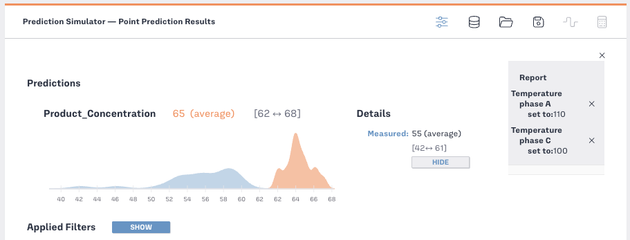Use Case Description
Background
A golden batch is a batch during production that had met optimal quality metrics. Golden batches serve as a benchmark or standard for comparing subsequent production batches. By analyzing and replicating the conditions under which a golden batch was produced, plant operators can aim to consistently achieve these optimal conditions in future production runs.
Problem
Quality metrics in batch production can vary widely, often influenced by raw material variations, different batch durations, shifting environmental conditions and variation in plant utilities throughout different stages of production.
Process and quality engineers in the plant must promptly identify the factors that could lead to subpar quality metrics. Their challenge is to find ways to maintain these quality metrics close to at the optimal standards, all while avoiding major alterations to standard operational procedures.
Adjust process parameters at critical decision points to ensure quality metrics fall within the ranges at or near that of the golden batch, without significant modifications to standard operational practices.
In the context of continuous improvement methodologies like Lean Manufacturing and Six Sigma, the concept of a golden batch is integral for efforts in minimizing variability and defects in quality metrics. However, these methodologies, which rely on statistical analysis and manual hypothesis testing, can become quite complex.
This complexity is amplified by the vast amounts of tabular and time series data from Laboratory Information Management Systems (LIMS) and Process Information Management Systems (PIMS) respectively, and the detailed analysis required to understand the interactions among various process variables and process constraints.
Neglecting to efficiently and safely manage these critical aspects can lead to several challenges including:
- Reduced revenue due to quality metrics that fall short of expectations.
- Prolonged periods spent on diagnosing the problem and applying modifications to the process that may have little to no impact on the quality metrics.
Click here to download the entire Playbook
Fero Labs Solution
Process engineers can employ Fero as a digital twin to precisely fine-tune a select number of operational parameters that have the most impact on the underperforming batches within the production process. Utilizing Fero Labs, they can quickly identify the most impactful process parameters and deviations from the golden batch, subsequently leveraging Fero’s “Group Prediction Simulator” to explore various “what-if” scenarios in a single, streamlined process.
This involves making adjustments to these important process parameters to see how changes to them could have improved the outcomes of underperforming batches. This functionality not only helps in achieving the desired quality but also facilitates strategic decision-making by offering a virtual testing ground for testing and improving the production process.
Once tested, process engineers can use this knowledge to determine the necessary set-points to adjust in their process.

Process & Business Outcomes
Identify the root causes of out-of-specification quality metrics
With Fero's Root Cause Explorer, plant engineers can swiftly identify which variables impact batch quality —often within minutes. Utilizing Fero enhances overall process comprehension, allowing the team to rapidly determine the most influential factors out of hundreds that affect batch quality.
Conduct 'what-if' simulations to gauge the effects of process modifications
Fero's Group Prediction Simulator lets the plant engineers test hundreds of different “what-if” operating scenarios for underperforming batches. This feature assists plant managers to make slight adjustments to the most relevant process set-points across the entire operation. Such targeted adjustments can save plant engineers several days or even weeks of analysis, streamlining the process improvement efforts.
Gain approval from top-level management to make process adjustments
Virtual testing with Fero enables boost plant engineers’ confidence in predicting how changes will impact future batch quality. After validating their hypotheses through Fero’s simulations, plant engineers can confidently approach top-level management and quickly build trust to adjust several process set-points within the plant, facilitating rapid implementation of necessary adjustments within the production process.
Fero Labs Adoption Timeline
Plant teams can collaborate to set up and deploy Fero Labs. Below is a timeline highlighting typical steps. With Fero’s easy-to-use, no-code interface, this can be achieved in a matter of weeks, not months or years.
Data Requirements
Plant teams can collaborate to set up and deploy Fero. Below is a timeline highlighting typical steps. With Fero’s easy-to-use, no-code interface, this can be achieved in a matter of weeks, not months or years.
Activating This Use Case
Consider our Industrial Use Case Playbooks as inspiration and tactical ideas for your team to align on to maximize the efficiencies of your plant.
Each Playbook has a matching Use Case Blueprint which provides more detailed steps to activate each use case within the Fero Labs platform.
If you’re curious to see these in action please book a free feasibility study with our team!
Together, let us continue to push the boundaries of what's possible, driving towards a future where industrial manufacturing is not just efficient and sustainable but truly transformative in its impact on society and the world at large.
Thank you for joining us on this journey, and we look forward to continuing to partner with you in your pursuit of excellence.
Download the entire Golden Batch Analysis Use Case Playbook to access additional tables and details about this industrial use case.







